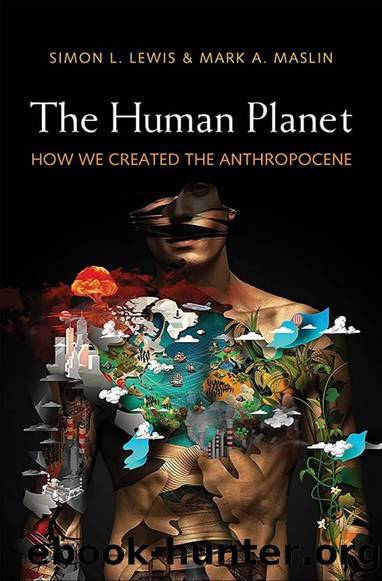The Human Planet: How We Created the Anthropocene by Simon L. Lewis

Author:Simon L. Lewis [Lewis, Simon L.]
Language: eng
Format: epub
ISBN: 9780241280881
Google: dLyMEAAAQBAJ
Amazon: 0241280885
Goodreads: 33877058
Publisher: PELICAN
Published: 2018-06-07T03:00:00+00:00
Figure 7.1 â Rising global energy consumption, 1830â2010, in exajoules. The prefix exa- means adding 18 zeros to the number shown. Current energy use is about 550 exajoules, which is the same as 550 quintillion joules, or put another way 550 billion trillion joules. One joule is approximately the energy required to lift a 100 gram object vertically to one metre above the Earthâs surface.7
Other aspects of the human component of the Earth system also grew fast after 1945. Increased food production led to more freshwater and fertilizer use, while mass-produced goods such as the motor vehicle rapidly increased, numbering about 1.3 billion by 2015, as seen in Figure 7.2. These changes then altered the rest of the Earth system, including the atmosphere, shown in Figure 7.3, the oceans, depicted in Figure 7.4, and the land surface and wider biosphere, indicated in Figure 7.5. Collectively they illustrate increasingly large changes to our home planet; an ever-larger human fingerprint on the Earth system.
One way that energy, industrialization and the ability to feed ever-more people all came together is the fixing of nitrogen from the atmosphere to manufacture crop fertilizers. In the early twentieth century the invention of the HaberâBosch process allowed the conversion of nitrogen to ammonia. Its inventors, German chemists Fritz Haber and Carl Bosch, developed the process by reacting atmospheric nitrogen with hydrogen under high temperatures and pressures with a metal catalyst. Initially, they wanted to create powerful explosives. Indeed, without the HaberâBosch process the twentieth century would have been a lot less bloody. This process also had a second use, manufacturing nitrogen fertilizer.
Globally, the atmospheric nitrogen fixed for use as fertilizer is now 115 million tonnes per year, mostly in the form of anhydrous ammonia, ammonium nitrate and urea. In combination with high-yield crop varieties and pesticides, these fertilizers have quadrupled the productivity of agricultural land over the last century, allowing billions of additional people to live. To produce the same amount of food as is grown on croplands today, but without chemical fertilizers, would probably require three times the area. It is difficult to see how 7.5 billion people would be fed without them, given the unsuitability of much of the land that is not already planted with crops.
Download
This site does not store any files on its server. We only index and link to content provided by other sites. Please contact the content providers to delete copyright contents if any and email us, we'll remove relevant links or contents immediately.
Man-made Catastrophes and Risk Information Concealment by Dmitry Chernov & Didier Sornette(5956)
The Revenge of Geography: What the Map Tells Us About Coming Conflicts and the Battle Against Fate by Kaplan Robert D(4052)
Zero Waste Home by Bea Johnson(3804)
COSMOS by Carl Sagan(3588)
Good by S. Walden(3518)
In a Sunburned Country by Bill Bryson(3506)
The Fate of Rome: Climate, Disease, and the End of an Empire (The Princeton History of the Ancient World) by Kyle Harper(3030)
A Wilder Time by William E. Glassley(2833)
Camino Island by John Grisham(2778)
Organic Mushroom Farming and Mycoremediation by Tradd Cotter(2661)
The Ogre by Doug Scott(2657)
Human Dynamics Research in Smart and Connected Communities by Shih-Lung Shaw & Daniel Sui(2479)
Energy Myths and Realities by Vaclav Smil(2463)
The Traveler's Gift by Andy Andrews(2435)
9781803241661-PYTHON FOR ARCGIS PRO by Unknown(2342)
Inside the Middle East by Avi Melamed(2325)
Birds of New Guinea by Pratt Thane K.; Beehler Bruce M.; Anderton John C(2236)
A History of Warfare by John Keegan(2212)
And the Band Played On by Randy Shilts(2165)
